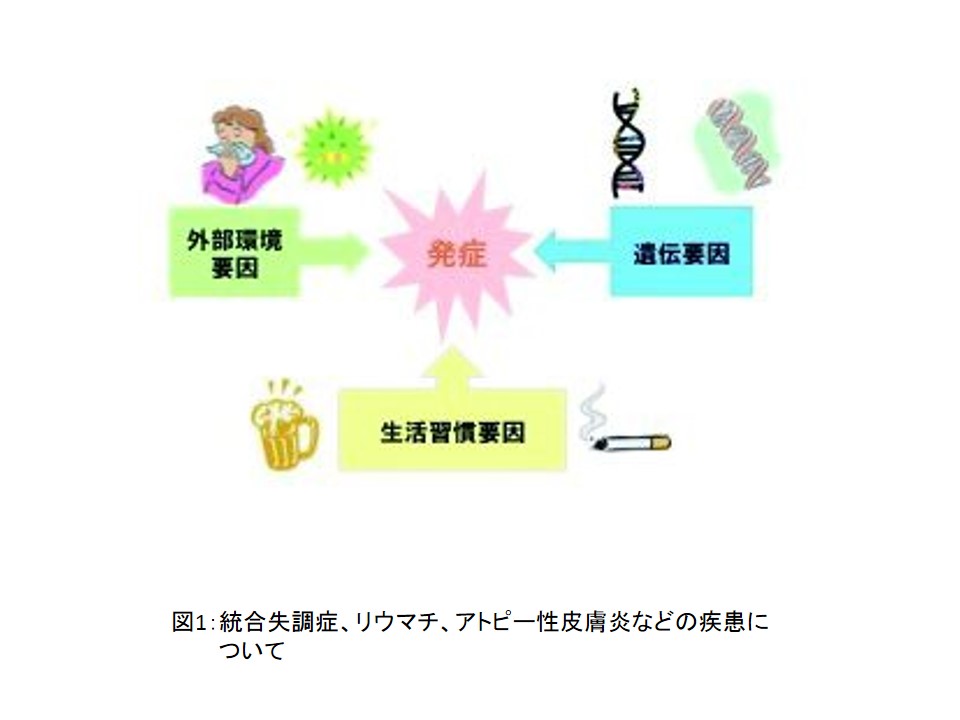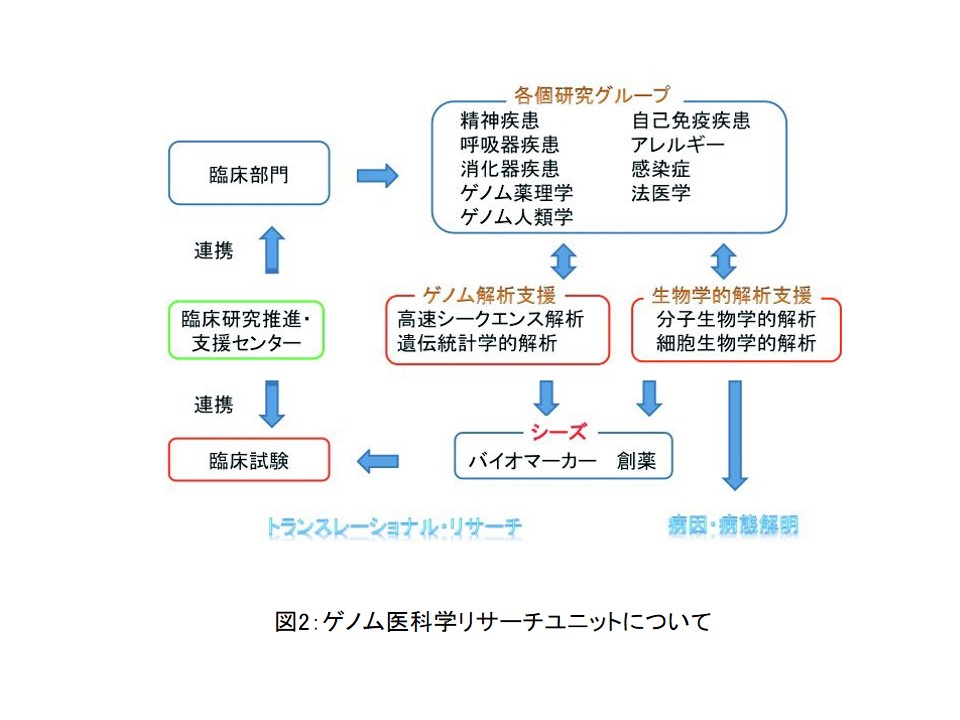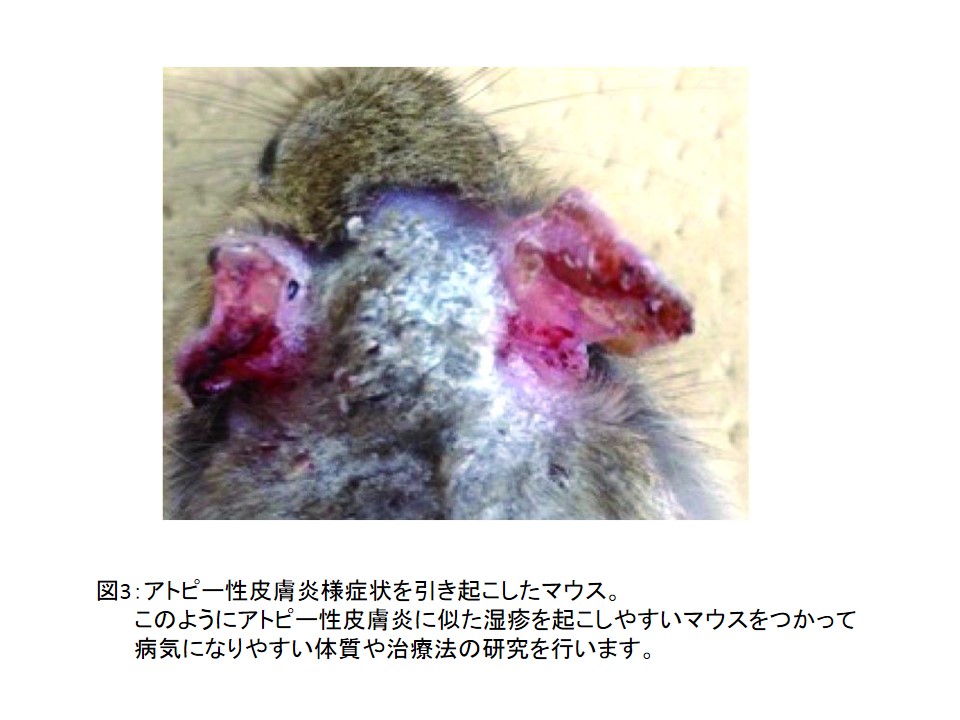キーワード:ゲノム医科学、人類遺伝学、疾患関連遺伝子、ゲノム薬理学、パーソナル・ゲノム
 アレルギーになりやすい人と、なりにくい人。薬が効きやすい人と、効きにくい人。太りやすい人と、太りにくい人。なぜ、人によって体質が異なるのでしょうか。実は、体質の個人差を説明するカギは、みなさんが持っているゲノム配列の中に隠されているのです。本リサーチユニットでは、ヒトゲノム解析から、疾患にかかりやすい原因、薬が効きやすい原因、薬の副作用が出やすい原因を明らかにし、個別化医療や創薬へつなげることを目指しています。
アレルギーになりやすい人と、なりにくい人。薬が効きやすい人と、効きにくい人。太りやすい人と、太りにくい人。なぜ、人によって体質が異なるのでしょうか。実は、体質の個人差を説明するカギは、みなさんが持っているゲノム配列の中に隠されているのです。本リサーチユニットでは、ヒトゲノム解析から、疾患にかかりやすい原因、薬が効きやすい原因、薬の副作用が出やすい原因を明らかにし、個別化医療や創薬へつなげることを目指しています。
ゲノム配列のわずかな違いにより、体質に個人差がでる
統合失調症、リウマチ、アレルギーなどの疾患は、もともとそれら疾患にかかりやすいという「体質」に、「環境要因」、「生活習慣要因」が加わって発症する と考えられています(図1)。体質の個人差は、ゲノム配列のわずかな違いと密接に関係しています。集団内で一定以上の頻度で生じるゲノム配列の違いは、ゲ ノム多型と呼ばれています。私たちは、ヒトゲノム解析を用いて、どの遺伝子・ゲノム領域の多型やそれより稀なゲノム変異が、疾患へのかかりやすさ、薬の効きやすさ、薬の副作用の出やすさに関わっているのかを解析しています。

ゲノム医科学研究をとおして、個別化医療・創薬をめざす
私たちは、さまざまな疾患に対して、まず患者さんと健康な人のゲノム配列を比べて、患者さんだけに偏った多型パターンがあるかどうかを探します。そして、患者さん特有の多型パターンを解析後、疾患へのかかりやすさを決定する遺伝子を特定し、疾患の分子メカニズムを解析することで、疾患に関わる分子をターゲットとした薬の発見を目指しています(図2)。たとえばアトピー性皮膚炎*1では患者さんのDNAやアトピー性皮膚炎になりやすいマウスを使って研究をしています(図3)。私たちのリサーチユニットでは体質を基にした発症メカニズムの解明と治療法の探索を様々な疾患について行っています。
将来的には、個々の患者さんのゲノム情報に応じた、最適な治療プランの提供を目指しています。


社会への貢献・実績
● 疾患感受性遺伝子や臨床経過関連遺伝子、薬剤応答性関連遺伝子の同定、人類学・法医学的研究の促進
● 高速シークエンサーを利用した解析による、病因的ゲノム多様性・変異部位や、疾患関連ゲノム構造多様性の解明
● 病因的ゲノム多様性・変異部位の機能解析による、病因パスウェイと創薬のシーズの解明
● 創薬やバイオマーカーのシーズに対する、臨床研究施行体制の構築
● 稀少疾患や疾患多発家系のパーソナル・ゲノム解析システムの構築により、ゲノム診療に貢献
● 今後の医学研究者、医療従事者に必須であるゲノム医科学教育に対応
(取材:平成25年10月16日)
Optimal Treatments Based on Patients’ Genome Sequences
Unit members : Furukawa, Hiroshi Sakamoto, Tohru Sugano, Yukiko Kawakami, Yasushi Homma, Masato Honda, Katsuya Noguchi, Masayuki Suzuki, Hideo Warabi, Eiji
Key words: genomic medicine, human genetics, disease-associated genes, pharmacogenomics, personal genome
Some patients are susceptible to allergies, while others are not. Some patients can be treated by drugs, while others cannot. Some patients easily gain weight, while others do not. Why do such constitutional differences exist among individuals? Some of such differences can be explained by genome sequences.  Our research unit conducts human genome analyses to elucidate the mechanisms of disease susceptibility and the efficacy and adverse effects of drugs, aimed at personalized medicine and drug discovery.
Our research unit conducts human genome analyses to elucidate the mechanisms of disease susceptibility and the efficacy and adverse effects of drugs, aimed at personalized medicine and drug discovery.
Slight differences in genome sequences result in constitutional differences among individuals.
Diseases such as schizophrenia, arthritis, and allergies are believed to be caused by “constitutional predispositions,” “environmental factors,” and “lifestyle factors” (Figure 1). Constitutional differences among individuals are closely related to slight differences in genome sequences. Differences in genomic sequences, detected at a frequency higher than 1% in the population, are referred to as genomic polymorphisms. Human genome analyses are employed to identify gene and genomic polymorphisms and rare genomic mutations involved in disease susceptibility and the efficacy and adverse effects of drugs.
Personalized medicine and drug discovery are the goals of genomic medicine.
Genome sequences are compared between patients and healthy individuals to identify polymorphisms responsible for predispositions to various diseases. Polymorphisms specific to patients are analyzed to identify genes responsible for disease susceptibility. The molecular mechanisms of diseases are analyzed to discover drugs that target molecules involved in the diseases (Figure 2). For example, DNA samples from patients with atopic dermatitis and mice prone to the condition are used to investigate atopic dermatitis*1 (Figure 3). Our research unit elucidates the pathogenic mechanisms of various diseases and develops treatments based on constitutions.
In the future, we will provide optimal treatment plans based on patients’ genomic information.
*1: Atopic dermatitis is a chronic inflammatory disease involving itching of the skin, which repeats remission and deterioration. It affects wide age groups from infants to adults.

Figure 2: Genomic Medicine Research Unit

Figure 3 : Mouse with atopic dermatitis-like symptoms Disease susceptibility and treatments are investigated using mice prone to atopic dermatitis-like eczema.
Social contributions and achievements
●Identification of disease susceptibility and clinical course- and drug response-related genes and promotion of anthropological and forensic studies.
●Elucidation of genomic diversity, mutation sites, and genome structure diversity causing diseases by analyses using high-speed sequencers.
●Elucidation of pathogenic pathways and drug discovery seeds by functional analyses of genomic diversity and mutation sites.
●Establishment of a clinical research system for drug discovery seeds and biomarkers.
●Contribution to genome medical practice through the construction of personal genome analysis systems for rare and familial diseases.
●Education in genomic medicine essential for medical researchers and health care workers in the future.

